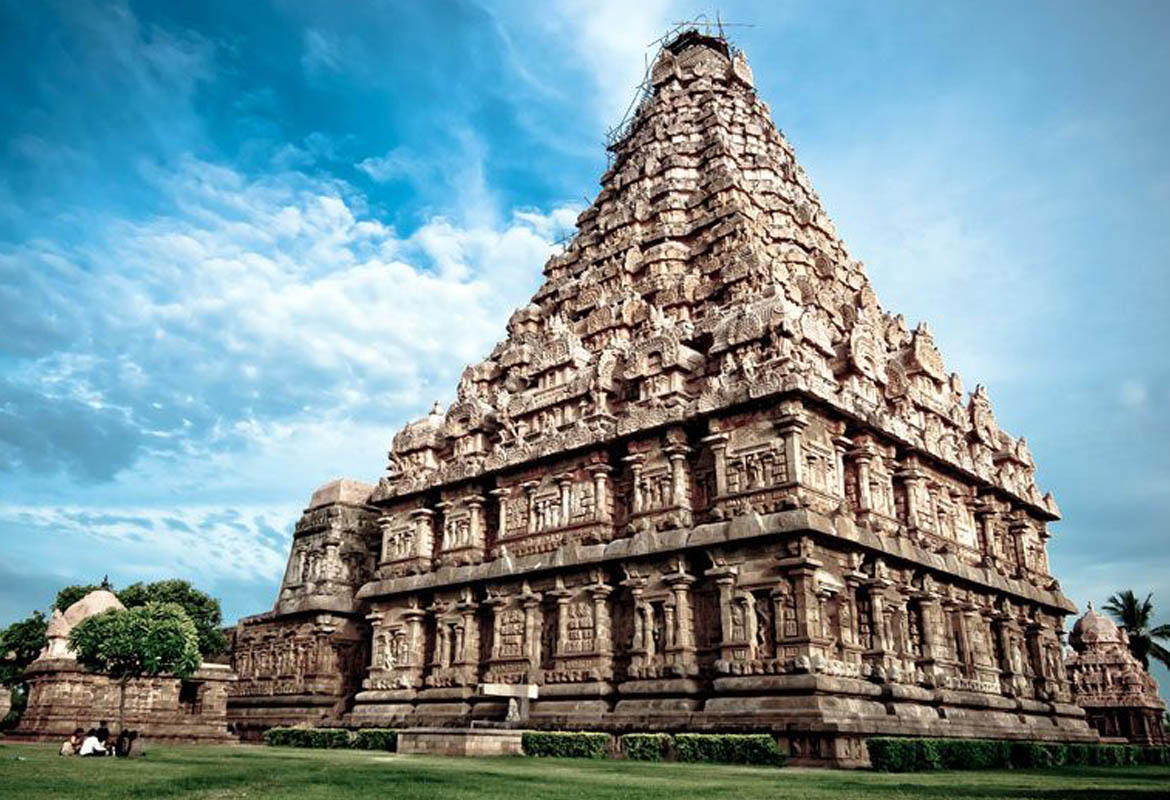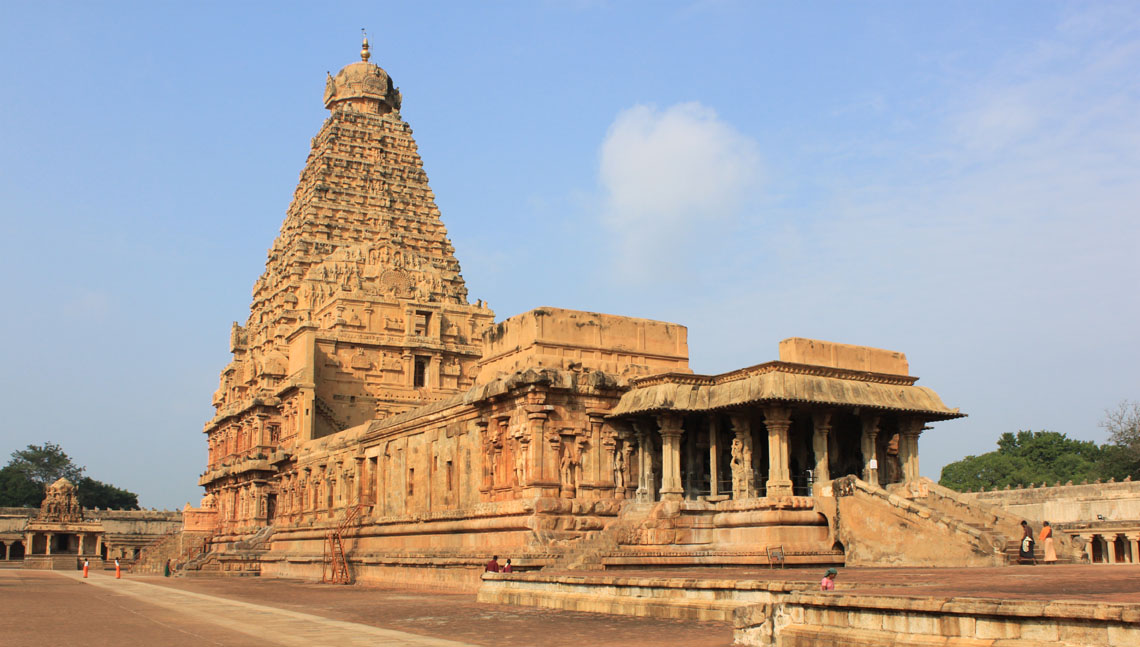Thanjavur, also known by its anglicised name Tanjore, is a municipality and the headquarters of the Thanjavur district in the Indian state of Tamil Nadu. It has a population of a 221,185 (2001 census).It is one of "must see" tourist spots in Tamil nadu.The name Thanjavur is derived from "Tanjan", a legendary asura in Hindu mythology. Thanjavur is one of the oldest cities in India and has a long and varied history dating back to Sangam period. The city rose into prominence during the rule of the Later Cholas when it served as the capital of the Chola empire. After the fall of the Cholas, the city was ruled by the Pandyas, Vijayanagar Empire, the Madurai Nayaks, the Thanjavur Nayaks, the Thanjavur Marathas and the British. It has been a part of independent India since 1947.
Attractions:
Sri Brihadeshvara Temple: This finest granite structure is now a UNESCO World heritage site. Completed in AD 1010 and dedicated to Lord Shiva, it was built by Rajaraja Chola I as a symbol of the unrivalled power and might of the Cholas. The temple basement is covered with inscriptions that give details of the temple's administration and revenue, and provide valuable historical information on Chola society and government.The temple is constructed using granite, mostly of large blocks, a rock that is not available in the neighborhood and had therefore to be brought from a distance- itself a colossal task. The plinth of the Central Shrine is 45.72 square m., the shrine proper 30.48 square m. and the vimana 60.96 m. high. On the massive plinth, covered throughout with inscriptions, there are niches on three sides in two rows, containing representations of deities such as Siva, Vishnu and Durga.The entire wall space and ceiling of the passage were originally covered with exquisite paintings; a coat of paintings, executed during the Nayak period in the seventeenth century, now obscures most of them.
Schwartz Church :The 18th century Schwartz Church or Christ Church is a legacy of Tanjore's colonial past, standing to the east of the Shivaganga Tank. This church was constructed by the Danish missionary, Reverend Frederik Christian Schwartz in 1779. When he died, the enlightened Maratha ruler Serfoji II donated a striking marble tablet to the church. This tablet made by John Flaxman has been placed at the western end of the church. It depicts the dying missionary blessing his royal patron, surrounded by ministers and pupils from the school that he established.
Royal Palace (Maratha Palace): This palace was originally built by Nayaka rulers as their royal residence and was further reconstructed by Maratha rulers. A large quadrangular courtyard leads into the palace complex. Outside the palace there is a seven-storeyed observation tower meant for the royal families.The splendid Maratha Durbar Hall, built by Shahji II in 1684 has elaborately decorated pillars, walls and ceilings. The Durbar Hall now houses the Rajaraja Museum and Art Gallery with an impressive collection of bronze and stone idols dating from 7th to 20th centuries. Next to the museum is the Saraswati Mahal Library, constructed by the Maratha rulers. This is one of the most important reference libraries in India. An adjoining museum known as Royal Museum displays personal collection of Serfoji II.
Darasuram: The town is known for the Airavateswara temple constructed by the Rajaraja Chola II in the 12th century AD. The temple is a recognised UNESCO World Heritage monument.
Kumbakonam: This town is known as the "temple town" due to the prevalence of a number of temples here and is noted for its Mahamaham festival which attracts people from all over the globe. The main products produced are brass, bronze, copper and lead vessels, silk and cotton cloths, pottery, sugar, indigo and rice.
Gangaikonda Cholapuram: This was erected as the capital of the Cholas by Rajendra Chola I, the son and successor of Rajaraja Chola, the great Chola who conquered a large area in South India, Sri Lanka, Bangladesh, Sumatra, Kadaram (Kedah in Malaysia) at the beginning of the 11th century A.D. It occupies an important place in the history of India.The great temple of Siva at this place is next only to the Brihadisvara temple at Thanjavur in its monumental nature and surpasses it in sculptural quality.The Gangaikondaan temple is an architectural and engineering marvel because the shadow of the main tower never falls on the ground throughout the year.
Bronze Casting: Tanjore is very famous fro Bronze Casting.Chola period bronzes were created using the lost wax technique. It is known in artistic terms as "Cire Perdue". The Sanskrit Shilpa texts call it the Madhu Uchchishtta Vidhana.Beeswax and kungilium (a type of camphor) are mixed with a little oil and kneaded well. The figure is sculpted from this mixture fashioning all the minute details. This is the wax model original.The entire figure is then coated with clay made from termite hills until the mould is of a necessary thickness. Then the whole thing is dried and fired in an oven with cow-dung cakes. The wax model melts and flows out, while some of it vapourises.The metal alloy of bronze is melted and poured into the empty clay-mould. This particular bronze alloy is known as Pancha Loham. When the metal has filled all crevices and has settled and hardened and cooled, the mould is broken off. The bronze figure thus obtained is then cleaned, finer details are added, blemishes are removed, smoothened, and polished well. Hence each bronze icon is unique and the mould cannot be used to create copies.
Tanjore Paintings: It is a major form of classical South Indian painting from the town of Thanjavur (anglicized as Tanjore) in Tamil Nadu, India. The art form dates back to about 1600 AD, a period when the Nayakas of Thanjavur encouraged art—chiefly, classical dance and music—as well as literature, both in Telugu and Tamil. Tanjore paintings are known for their surface richness, vivid colors, compact composition and especially the glittering gold foils used to give the paintings their rich look . Essentially serving as devotional icons, the subjects of most paintings are Hindu gods, goddesses, and saints. Episodes from Hindu tradition are drawn upon as elaborations of the main figure or figures placed in the central section of the picture. Tanjore paintings are panel paintings done on solid wood planks, and hence referred to as palagai padam (palagai = "wooden plank"; padam = "picture") in local parlance. In modern times, these paintings have become souvenirs of festive occasions in South India, pieces to decorate walls, and collectors' items for art lovers.










